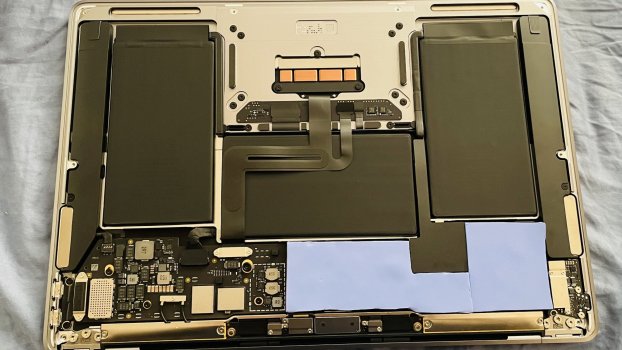Hi all just "upgraded" from an early 2020 MBA i3 to the M1 MBA 8/256. 2020 lurker here.
On my prior i3 MBA, I had performed the thermal pad mod with great results as shown with various users in the extensive thermal mod thread. lol at that laptop performance compared to the M1.
I ordered the 200mm x 200mm x 3mm thermal pad and it will be arriving tomorrow. The 3mm is because the heat sink appears to sit lower and therefore farther from the back case when it is closed. The 3mm will ensure contact to the aluminum.
Since the heat sink on the M1 MBA is an elongated piece from the processor all the way to the edge, I plan to cover the whole piece edge to edge. Since this processor barely breaks a sweat I will also remove the sticky tape covering on the case to ensure best adhesion. I have no issue with additional heat that will be on the backside since I know this processor barely heats up doing mainstream things.
Geekbench doesn't seem to have any impact on M1 thermal since the processor barely heats up to 50C without breaking a sweat through multiple repeated runs of up to 5 times with no change to score.
The test will be performed with Cinebench R23 through the 10 minute thermal test run for multicore to see if the score drops into the low 6000s or not. On the single loop, multicore runs from YouTube it seems the M1 MBA and MBP are aligned in scores and only on the 2nd or 3rd run does the MBA begin to throttle.
Any input, please provide.
Stay tuned.
EDIT: 10 minute and 30 minute cinebench runs performed with incredible results shown in page 1 and page 2 of this thread.
On my prior i3 MBA, I had performed the thermal pad mod with great results as shown with various users in the extensive thermal mod thread. lol at that laptop performance compared to the M1.
I ordered the 200mm x 200mm x 3mm thermal pad and it will be arriving tomorrow. The 3mm is because the heat sink appears to sit lower and therefore farther from the back case when it is closed. The 3mm will ensure contact to the aluminum.
Since the heat sink on the M1 MBA is an elongated piece from the processor all the way to the edge, I plan to cover the whole piece edge to edge. Since this processor barely breaks a sweat I will also remove the sticky tape covering on the case to ensure best adhesion. I have no issue with additional heat that will be on the backside since I know this processor barely heats up doing mainstream things.
Geekbench doesn't seem to have any impact on M1 thermal since the processor barely heats up to 50C without breaking a sweat through multiple repeated runs of up to 5 times with no change to score.
The test will be performed with Cinebench R23 through the 10 minute thermal test run for multicore to see if the score drops into the low 6000s or not. On the single loop, multicore runs from YouTube it seems the M1 MBA and MBP are aligned in scores and only on the 2nd or 3rd run does the MBA begin to throttle.
Any input, please provide.
Stay tuned.
EDIT: 10 minute and 30 minute cinebench runs performed with incredible results shown in page 1 and page 2 of this thread.
Last edited:


